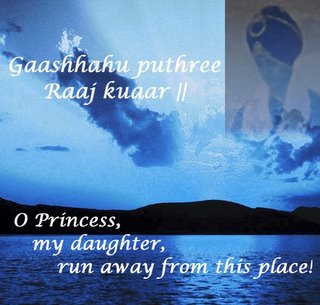A Sikh Girls Prayer

Born and raised in a world full of hate
Enraged by the injustices her sisters faced
No place or home to call her own
Born into a family which is not her own
Knowing everyday as she’s grown
One day her hand will be given to a man unknown
Searching for an abode which can be called her own
Realizing at her tender age,
That is none other than with the Charna of the Lord
For a girl to be accepted in this world
So much she has to bear
Sentenced to a world of silence
No room for what she has to share
Loved ones come and go
Their love and faces forever changing
We are forever searching for acceptance
Not realising for years how our sisters have been treated
1984 and for years before
Our sisters, abducted, raped, betrayed by people they thought of as their own
No one here is ours
We are musafirs on this earth
We belong with our Lord
If only we could witness an ounce of the strength of the ones before
Gave up their ‘all’ for the Lord
Gurujis love remains the same, forever strong
Forever carrying His daughters through their struggles
Without His shelter we have no home,
My home, my love, life, my everything, all within the truest form of love
A taste of this love we receive,
From parents, siblings, friends
But a taste is all it remains
Until the ultimate love is realized
The purest kind of love
The only endless love
Dearest sweet Akal Puraak Ji,
Grant me the wisdom and courage to walk on your path
Forever be close to my heart
Keep my love strong
Help me forgive those who cause my struggles and the struggles of my sisters
Never let me forget the sacrifices our Shaheeds made for us
May all my sisters who have suffered be granted the peace love and acceptance,
That I have found within your Chrnaa
Forever your Daughter
Dastar For Women
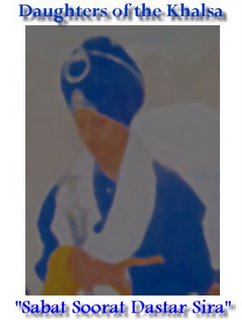 The Dastar (turban) is a very important part of Sikh religion. To Sikhs it is more than what is a crown to a king or queen. The Sikh Gurus showed a great respect to the turban. But some people think it is only for men, and women are not required to wear it. This article will explain why Sikh women should wear the Dastar (turban).
The Dastar (turban) is a very important part of Sikh religion. To Sikhs it is more than what is a crown to a king or queen. The Sikh Gurus showed a great respect to the turban. But some people think it is only for men, and women are not required to wear it. This article will explain why Sikh women should wear the Dastar (turban).
Sri Guru Granth Sahib Ji, Guru Ji says:
naapaak paak kar, hadoor hadeesaa; saabat soorat dastaar siraa. 12
Purify what is impure, and let the Lord's Presence be your religious tradition. Let your total awareness be the turban on your head. 12 (Ang 1084, SGGS)
Guru Gobind Singh Ji and Rehtname (codes of conduct) make very clear points about women wearing Dastar.
"Jab Lab Khaalsa Rehe Niaara, Tab Lag Tej Diyoo(n) Mai Saara"
"As long as Khalsa preserves its uniqueness and follows the path of true Guru I will bless them with all of my powers."
"Khalsa Mero Roop Hai Khaas"
"Khalsa is my own self image."
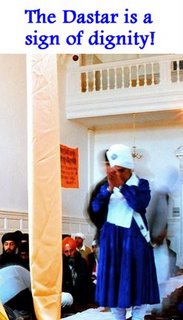
Men still have their dignity but where is the women's dignity? They have lost it to fashion. Not many Sikh women wear a Dastar but their numbers are steadily growing. Even white Sikhs men and women wear Dastars. Women must wear the turban as instructed by Guru Ji himself because that's what makes them unique and an image of Guru Ji.
Right up to the reign of Maharaja Ranjit Singh, Sikh women had been steadfast in following the edicts of the Satguru (True Guru) in respect to their spiritual inne r life as well as dress, including the Dastar. That is what J. D. Cunningham himself saw and wrote in the middle of the Nineteenth Century when he wrote his book, ‘History of the Sikhs’. He writes: "The Sikh women are distinguished from Hindus of their sex by some variety of dress but chiefly by a higher top knot of hair." Even after the Panjab came under the British rule, the Dastar was conspicuously seen in the case of Sikh women as well as men right up till the Gurdwara movement and the establishment of the Shiromani Gurudwara Prabandhak Committee in 1926. Until then, no one - men or women were allowed initiation (by taking Amrit) at Sri Akal Takhat Sahib without a Dastar. At the end of the nineteenth century and the beginning of the present one, as a result of the Sikh renaissance movement, a number of Khalsa schools for girls were established in Punjab. A small Dastar was prescribed as an obligatory head dress for students as well as for teachers in such schools at Jaspalon, Ferozepur and Sidhwan in Punjab. Many famous Rehatname also support wearing of Dastaar.
r life as well as dress, including the Dastar. That is what J. D. Cunningham himself saw and wrote in the middle of the Nineteenth Century when he wrote his book, ‘History of the Sikhs’. He writes: "The Sikh women are distinguished from Hindus of their sex by some variety of dress but chiefly by a higher top knot of hair." Even after the Panjab came under the British rule, the Dastar was conspicuously seen in the case of Sikh women as well as men right up till the Gurdwara movement and the establishment of the Shiromani Gurudwara Prabandhak Committee in 1926. Until then, no one - men or women were allowed initiation (by taking Amrit) at Sri Akal Takhat Sahib without a Dastar. At the end of the nineteenth century and the beginning of the present one, as a result of the Sikh renaissance movement, a number of Khalsa schools for girls were established in Punjab. A small Dastar was prescribed as an obligatory head dress for students as well as for teachers in such schools at Jaspalon, Ferozepur and Sidhwan in Punjab. Many famous Rehatname also support wearing of Dastaar.
Here are some quotes:
"Each candidate for Baptism be made to wear kachera, tie hair in a topknot and cover the same with Dastar; wear Sri Sahib (Kirpan) in Gatra (shoulder belt). Then he/she should stand with folded hands." (Rehatnama Bhai Daya Singh Ji)
"...Waheguru Ji Ka Khalsa should keep hair unshorn, have flowing beard and have simple Dastar which saves from impiety. Then the Sikhs asked what would happen to those Amritdhari who start cutting their hair or do not keep their hair covered. The Guru replied that they would be stupid and would lose their sensibility. It is a blemish to remain bareheaded...Always keep two turbans. When the bigger turban is removed, the smaller be kept. The smaller turban should not be removed."(Bijai Mukat Dharam Shastra - Sakhi-8)
"(A Sikh) who eats food with turban removed from the head (i.e., bareheaded) is destined for 'Kumbhi' (hell)." (Rehatnama Bhai Prahlad Singh Ji)
"One who combs hair twice a day, ties turban fold by fold and cleans teeth daily will not come to grief." (Tankhah Naama Bhai Nand Lal Ji)
"Whosoever roams about bareheaded, takes food bareheaded and distributes the 'prasad' bareheaded is considered punishable." (Uttar-prashan Bhai Nand Lal Ji)
"Women should tie their hair in topknot and should not keep them loose." (Rehatnama Bhai Daya Singh Ji)
"Keshas be washed. Turban or Dastar should not be placed on floor but should always be kept with due respect. Food should not be eaten bareheaded." (Bijai Mukt Dharam Shastra, Sakhi 70)
It is thus, absolutely clear from the above quotations that remaining bareheaded at any time (except when washing, drying, and combing the hair) and keeping hair loose and unknotted are basically against the Sikh Code of Conduct, which is applicable to all, men and women alike. For obvious reasons, therefore, the use of Dastar is indispensable. There is no other way to keep the head covered all the time. Sikh women who wear only dupattas, mostly remain bareheaded, especially in the privacy of their own homes, while taking food, etc., and thus are, perhaps unconsciously, infringing the Sikh Code of Conduct in this respect.
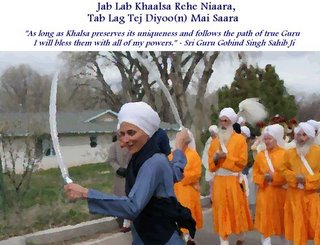
A Singhni-At-Arms

How dared you quit the fort,
O forty thankless cowards!
You love your lives more
than the Guru, who ever fights
for your honor and rights.
He put his all at stake
and suffers for your sake
You know the spirit of Guru
whom no one can subdue.
Go, get your error atoned
or forever you will rue.
We are shamed, the forty said,
as from the Guru we had fled
but how can we face him again
who has borne such loss and pain.
O Mai Bhago, take us to him
with regret we are full to the brim.
At once the Singhni rode a steed
the forty galloped in her lead
they sought the Guru in Malwa belt
where with Mughals still he dealt.
As by Khidrana pond they passed
and saw the Mughal army massed
'The Guru must be here', they thought.
Now for him they fiercely fought
and havoc on Mughals wrought.
From atop a knoll nearby
Guru's arrows began to fly
the enemy army in panic ran
though forty fell to the last man.
Guru blessed the dead and dying
with love divine and grace
seeing Mahan Singh softly sighing
he held him in embrace.
Looking in the Guru's eyes
the bleeding Singh did moan-
'Tear the disclaimer, O forgiver,
redeem us as your own.'
From a pocket of his robe
the Guru took out a letter
he tore it up with grace
to close the painful matter.
It lit up dying Singh's face
and broke his bodily fetter.
The wounded Mai Bhag Kaur survived
and never quit the Guru's camp
heroism of the Singhni-at-arms
glows in history like a lamp.

...Vaheguru...Vaheguru...Vaheguru...
By: Pritam Singh (Grewal):Panthic Weekly
Mai Bhag Kaur Ji, How did it feel?
 Mai, Mai, Mai Bhag Kaur Ji, how did it feel?
Mai, Mai, Mai Bhag Kaur Ji, how did it feel?Mai Bhag Kaur Ji, how did it feel to be a Khalsa woman?
Mai Bhag Kaur Ji, how did it feel to be a Khalsa woman?
In this war torn world...
An ordinary woman, a farmer's wife
Mai Bhag Kaur Ji took a stand and lived a soldier's life
Her time had come to choose the path of bravery
Her dedication changed the course of history
When Mai Bhag Kaur Ji heard the news she shed no tears
Preparing for battle she felt no fear
When she raised the sword, she stood so tall
The forty all repented and followed her call
She charged into battle, a dust storm arose
A mighty tornado, the moguls froze
A warrior's heart, God's battle drum
Racing into war until justice is done
Her frontline Singh are slain one by one
Mai Bhag Kaur Ji still shines like the burning sun
Mai, Mai, Mai Bhago, how did it feel?
Mai Bhag Kaur Ji, how did it feel to be a Khalsa woman?
Mai Bhag Kaur Ji, how did it feel to be a Khalsa woman?
Devotee feels-- Without YOU fine quilts are just diseases pressing against the body, and our houses are just a pit of snakes.
In Memory of Chali Mukte
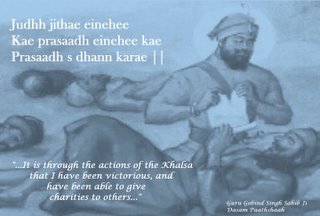
Forty (chali) liberated ones (mukte), is how a band of 40 brave Sikhs who laid down their lives fighting near the dhab or lake of Khidrana, also called Isharsar, on 29 December 1705 against a Mughal force in chase of Guru Gobind Sahib Singh Ji are remembered in Sikh history and daily in the Sikh ardas or supplicatory prayer offered individually or at gatherings at the end of all religious services. Guru Gobind Singh Sahib Ji, who had watched the battle from a nearby mound praised the martyrs' valour and blessed them as Chali Mukte, the Forty Immortals. After them Khidrana became Muktsar - the Pool of Liberation. Etymologically, mukta from Sanskrit mukt means 'liberated, delivered, emancipated,' especially from the cycle of birth and death. Mukti (liberation, emancipation) in Sikhism is the highest spiritual goal of human existence, and mukt or mukta is the one who has achieved this state of final beatitude. Mukta, also means a pearl, and the word would thus signify a title or epithet of distinction. It was probably in this sense that the five Sikhs, who on 30 March 1699 received the vows of the Khalsa immediately after the first five Panj Piare (q.v.), were blessed with the title mukta, plural mukte.
In the Sikh tradition the forty martyrs of Muktsar who earned this title by sacrificing their lives for the Guru and who redeemed their past apostasy of having disowned the Guru and deserted him driven to desperation by the prolonged siege of Anandpur by the hill chiefs and Mughal forces by having their disclaimer torn by the Guru. They were led by Mai Bhag Kaur and Mahan Singh Brar.
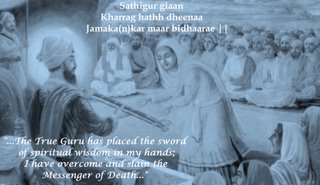
Mai Bhag Kaur: As a young girl, she heard sakhis of martyrdom of Sikh Gurus' and their disciples. A regular hearing of the sakhis and harassment by the tyrannous rulers made a deep effect on her tender heart. She decided in her mind to do her duty to stop such state violence against the Sikhs. She went to Anandpur Sahib along with his father in 1699 A.D., when Guru Gobind Singh Sahib ji founded the Khalsa Panth.
Mughals and hilly chiefs had surrounded Anandpur and were demanding it be evacuated. They called that any Sikh who says that "he/she is not anymore a Sikh of Guru Gobind" will be left untouched. A group of 40 Sikhs, led by Mahan Singh Brar told Guru Gobind Singh that they are not his Sikhs anymore. Guru told them that they have to write it in a document that "they are not his Sikhs anymore" and sign it.
"All forty Sikhs signed this document Bedava and left Guru Gobind Singh."
 Mahan Singh, who had been seriously wounded, also died as the Guru took him into his lap. Guru Gobind Singh blessed those forty dead as the Forty Liberated Ones. After the battle was won, Guru Gobind Singh asked Mai Bhag Kaur to go back to her village.
Mahan Singh, who had been seriously wounded, also died as the Guru took him into his lap. Guru Gobind Singh blessed those forty dead as the Forty Liberated Ones. After the battle was won, Guru Gobind Singh asked Mai Bhag Kaur to go back to her village.He took into his care Mai Bhag Kaurwho had also suffered injury in the battle. She there after stayed on with Guru Gobind Singh as one of his bodyguard, in male attire. After the death of Guru Gobind Singh at Nanded in 1708, she retired further south. She settled down at Jinvara, 11 km from Bidar in Karnataka where, immersed in meditation, she lived to attain a ripe old age. Her hut in Jinvara has now been converted into Gurdwara Tap Asthan Mai Bhag Kaur. At Nanded, too, a hall within the compound of Takht Sachkhand. Sri Hazur Sahib marking the site of her residence is known as Bunga Mai Bhag Kaur.
 Minus the spiritual understanding of the women, the 40 Liberated Ones would have never returned to their Guru and would have gone through lifetimes of karma to repay the mistake. These Khalsa women understood non-attachment, security in the Divine, living in the Will of God, loyalty to the Guru so well that they could fearlessly send their husbands to their death, knowing that it was better for their husbands to die in service of the Guru than to live any other way. And the pain of loosing their husbands was less to them than the pain of seeing their husbands loose their path to God. Publicly- the valour of the men prevailed. Privately- the wisdom of the women prevailed.
Minus the spiritual understanding of the women, the 40 Liberated Ones would have never returned to their Guru and would have gone through lifetimes of karma to repay the mistake. These Khalsa women understood non-attachment, security in the Divine, living in the Will of God, loyalty to the Guru so well that they could fearlessly send their husbands to their death, knowing that it was better for their husbands to die in service of the Guru than to live any other way. And the pain of loosing their husbands was less to them than the pain of seeing their husbands loose their path to God. Publicly- the valour of the men prevailed. Privately- the wisdom of the women prevailed.(1). Bhai Bhag Singh (2). Bhai Dilbag Singh (3). Bhai Mann Singh (4). Bhai Nidhan Singh (5). Bhai Kharbara Singh (6). Bhai Darbara Singh (7). Bhai Dyal Singh (8). Bhai Nihal Singh (9). Bhai Khushal Singh (10). Bhai Ganda Singh (11). Bhai Ishmer Singh (12). Bhai Singha (13). Bhai Bhalla Singh (14). Bhai Suhel Singh (15). Bhai Chamba Singh (16). Bhai Ganga Singh (17). Bhai Sumer Singh (18). Bhai Sultan Singh (19). Bhai Maya Singh (20). Bhai Massa Singh (21). Bhai Sarja Singh (22). Bhai Sadhu Singh (23). Bhai Gulab Singh (24). Bhai Harsa Singh (25). Bhai Sangat Singh (26). Bhai Hari Singh (27). Bhai Dhana Singh (28). Bhai Karam Singh (29). Bhai Kirt Singh (30). Bhai Lachman Singh (31). Bhai Buddha Singh (32). Bhai Kesho Singh (33). Bhai Jado Singh (34). Bhai Sobha Singh (35). Bhai Bhanga Singh (36). Bhai Joga Singh (37). Bhai Dharam Singh (38). Bhai Karam Singh (39). Bhai Kala Singh (40). Bhai Mahan Singh

Warrior Princess

I am a Princess, I wear a Crown
Don't let my Keshes go tumbling dawn
Instead I keep them neatly wound
Inside, beneath, my Keski, bound
I am a Princess, I let it show
I want everyone to know
I am daughter of a King, and so
I let 'each' one of my Keshes grow
I am a Princess, as royalty, I wear a Bana
With my breath do Simran, read Banee, learn Kathaa
My hands help with Langar, do shoe Seva
My hearts home is in my Fathers Castle, His Gurdwara
I am a Princess, I keep Panj Kakar
Precious gifts from Five Beloved Sevadar
Weapons to help me fight five enemies, win the 'world' war
I am a Warrior Princess, my name is KAUR
Mata Khivi Ji
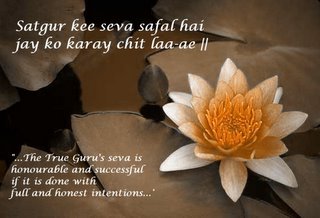
Mata Khivi was born in 1506 to Karan Devi and Bhai Devi Chand Khatri. Her father was a shopkeeper , and was a popular man in the neighbourhood. She inherited all his finest attributes of generosity and congenial spirit. She was married in 1519, when she was 13 years old. Khivi was married to Lahina for 20 years before he became the second Guru of the Sikhs.
 There is historical evidence that she had 4 children. Dasu, the eldest was born in 1524. Bibi Amro was born in 1532, followed by Bibi Anokhi in 1535 and son Datu in 1537. The family was content and doing well. As the wife of one of the town's richest men, Khivi must have enjoyed a great deal of respect. Her life was one of luxury and pleasure. Life would have gone on this way, had it not been for her coming under the influence of Mai Bhirai, who told her about Guru Nanak Sahib Ji's teachings. At approximately the same time, Lahina also heard of the Guru through Bhai Jodha, one of Guru Nanak Sahib Ji's earliest disciples. Lahina was a seeker of truth, and his curiosity was aroused.
There is historical evidence that she had 4 children. Dasu, the eldest was born in 1524. Bibi Amro was born in 1532, followed by Bibi Anokhi in 1535 and son Datu in 1537. The family was content and doing well. As the wife of one of the town's richest men, Khivi must have enjoyed a great deal of respect. Her life was one of luxury and pleasure. Life would have gone on this way, had it not been for her coming under the influence of Mai Bhirai, who told her about Guru Nanak Sahib Ji's teachings. At approximately the same time, Lahina also heard of the Guru through Bhai Jodha, one of Guru Nanak Sahib Ji's earliest disciples. Lahina was a seeker of truth, and his curiosity was aroused.In 1532, shortly after the birth of his first daughter Amro, Lahina set out for his annual pilgrimage. On the way, he broke his journey at Kartarpur to see the Guru. On lislening to Nanak speak, Lahina begged to be allowed to stay and become his disciple. He had found the truth he had been seeking, and would never again stray away from it. He served his master with the greatest devotion. He busied himself, sweeping the visitor's quarters, washing their clothes and helping with the most menial work in fields. As his knowledee and understanding of the new teachings grew, so did the Guru's affection and approval of his disciple. This created a problem for the Guru's sons. Increasingly they grew jealous of Lahina, and took no pains to conceal their dislike. Without a doubt, this kind of stress and strain would have been very difficult for Lahina's wife to deal with. There are no records of her thoughts or feelings or how she handled the situation. Had she behaved in a bad manner during this time, you can be sure that someone would have recorded it.
Lahina was 28 years old at the time, had a wife and two young children. The Guru he had chosen,
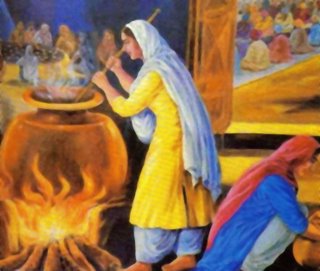 m, while he prayed and meditated for six months. He allowed her to supply him with milk, but otherwise asked to be left alone.
m, while he prayed and meditated for six months. He allowed her to supply him with milk, but otherwise asked to be left alone.Khivi continued to manage Guru Amar Das's kitchen. She was proud of her children till the day she died. Her daughter Bibi Amro had married Bhai Jasoo of Basarke village. He was the son of Bhai Manak Chand and nephew of Guru Amar Das. Bibi Amro had become a preacher of Sikhism, and it is she who transformed the life of Guru Amar Das by introducing him to the teachings she had learnt from her father Guru Angad Dev Ji. Later, when Amar Das organised the teaching of Sikhism into specific districts and jurisdictions, he gave her a Manji, that is, he appointed her head to a diocese. Being appointed to head a Manji would be the equivalent of being a bishop in the Christian Church. She was responsible not only to teach the quality of the preaching, but also for collecting revenues and making decisions for the welfare of her diocese. Her diocese or Manji included Basarke, her husband's village. Today, close to the modern village of Basarke an old tank (man-made pond) bears the name of Bibi Amro Da Talab (Tank of Bibi Amro) in her memory.
Mata Khivi ji had the distinction of meeting five Gurus. She lived to the age of 75 and died in the year 1582. Guru Arjun Sahib Ji attended her funeral. Her contributions to the Sikh cause can easily be divided into three parts. The first period was the twenty years of marriage before Guru Angad succeeded Guru Nanak. This period was a test not only for Angad, but for her as well. Any decisions he made affected her very much. Her response would also have affected his actions.
"...She never complained, nor did anything to deter him from his objectives..."
The second period of her life as wife of the Guru was extraordinary in its devotion and dedication to the cause. The third and last period would be after her husband died. She continued to nourish the Sikh community and to work tirelessly for that which she now believed in with all her heart.
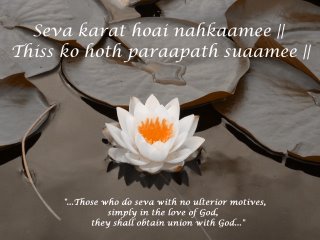
Bibi Nanaki Ji

Five years later, in 1469, her brother, Guru Nanak Sahib came to this world in Talwandi.
Bibi Nanaki Ji was the first to recognize that Guru Nanak was not an ordinary man.
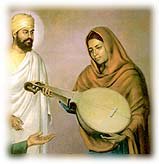 While Mehta Kalu Ji, Mata Tripta Ji, and others would get upset with Guru Nanak’s actions, Bibi Nanaki Ji would encourage her brother on his mission.
While Mehta Kalu Ji, Mata Tripta Ji, and others would get upset with Guru Nanak’s actions, Bibi Nanaki Ji would encourage her brother on his mission.There is no doubt that she was Guru Nanak’s first Sikh, first follower. All through her life, she did not think of Guru Nanak as her brother, instead she thought of him as her Guru. From an early age it became apparent that the brother and sister had a close relationship. There are many stories relating to their mutual affection and her deep faith in her brother's purpose in life.
She was with him throughout the early years of his childhood. When Guru Nanak Sahib was only Six years old in 1475, his sister was married to Jai Ram Ji, a revenue official from Sultanpur, which is in the present-day native state of Kapurthala, and was then the capital of the Jalandhar Doab. Bibi Nanaki was only eleven years old when she was married.
Guru Nanak continued to live with his parents in Talwandi, but his parents were very much stressed with him. Mehta Kalu Ji would get upset with Guru Nanak because he would spend all day meditating or visiting saints and would not do any work around the house. Before her marriage, Bibi Nanaki Ji would calm her father, but now that she had moved away there was no one to stand up for the Guru.
One day, Guru Nanak Sahib Ji saw a poor saint and gave him a brass jug from home and some gold. When Mehta Kalu Ji found out, he was very upset and scolded his son. After this incident, Rai Bular, the village Chief suggested that Guru Nanak should move to Sultanpur and live with his loving sister. Mehta Kalu Ji agreed and during his teenage years, Guru Nanak moved to Sultanpur.
When Guru Nanak came to Sultanpur, Bibi Nanaki started to bow to her younger brother. The Guru stopped her and told her that she was his older sister and she should not bow to him. However, Bibi Nanaki responded,
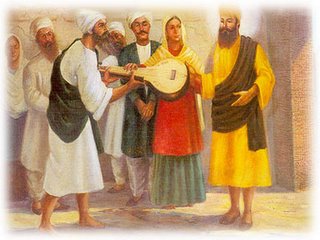
Bhai Jai Ram Ji worked for Nawab Daulat Khan, the governor. He decided to ask Nawab Daulat Khan if he could find some work for Guru Nanak. The Nawab met Guru Nanak and was very pleased with the Guru’s personality. He gave Guru Nanak a job in the modhi khana (general store).
Bibi Nanaki and Bhai Jai Ram Ji were also the ones who arranged Guru Nanak’s marriage to Mata Sulakhni Ji, daughter of Baba Mool Chand and Mata Chando Rani from the village of Pakhoke, district Gurdaspur.
When Guru Nanak went missing in the Beas River, everyone had given up hope, they all thought that the Guru had drowned in the River. Bhai Jai Ram Ji was even writing a letter to Guru Nanak’s parents telling them that their son had drowned. However, Bibi Nanaki Ji kept faith, she told her husband not to write the letter and she told everyone else,
She is the only one who kept faith:Besides Bibi Nanaki, all of the other people started to feel sad.
She treated Guru Nanak’s sons as her own, while Guru Nanak went on his preaching journeys, Mata Sulakhni Ji took the younger son, Baba Lakhmi Das Ji to her parents home. The older son, Baba Sri Chand Ji stayed in Sultanpur and lived with Bibi Nanaki and Bhai Jai Ram Ji.
During the rest of their lives, Guru Nanak visited his Sister many times. He had promised to visit her whenever her heart yearned to see him: Whenever Bibi Nanaki would remember her brother, he would come meet her right away. (Panth Prakash)
Save the World in the Company of Guru Ji’s Teachings
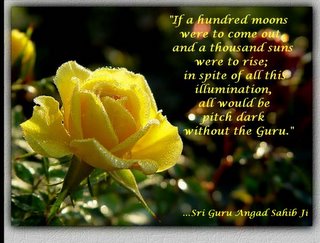 Vaheguru Ji Ka Khalsa
Vaheguru Ji Ka KhalsaVaheguru Ji Ke Fateh
The day has come
With His Grace
He has given us a chance
To wake up
To take power
To change the world
Oh beautiful woman
You are the soul
You are the heart
of all what He has created
He preached universal equality
He spoke for me, when no one else did
He enlightened the world by saying
Great Kings come from a woman
He is my Guru
He is my Guru
He is Sri Guru Nanak Sahib Ji
He gave me the ability to learn
He encouraged me to teach others
He made it clear to the world by saying,
women are the care-takers of our children
He is my Guru
He is my Guru
He is Sri Guru Angad Sahib Ji
He ended the malice murders of my sisters
He allowed me to show my face
He gave me the gift of confidence,
to look at the world and estimate its worth
He is my Guru
He is my Guru
He is Sri Guru Amar Das Sahib Ji
He showed me to be generous
He made me realize the gift of prayer
He told me those who work hard and
live a purposeful life, will be rewarded
He is my Guru
He is my Guru
He is Sri Guru Ram Das Sahib Ji
He taught me to listen and respect my elders
He gave me an eternal home, Sri Harminder Sahib Ji
He declared, by repeating God’s name,
all sins shall vanish
He is my Guru
He is my Guru
He is Sri Guru Arjun Sahib Ji
He said I am the conscience of a man
He showed me how to protect the poor and destroy tyrants
He told me to promote my faith, mediate on Guru Ji’s teaching,
and to keep all of his commandments
He is my Guru
He is my Guru
He is Sri Guru HarGobind Singh Sahib Ji
He gave me the desire to be simple
He told me to sing Guruji’s praises night and day
He showed me to be prepared for battle
both physically and spiritually
He is my Guru
He is my Guru
He is Sri Guru Har Rai Sahib Ji
He was quite young, yet his actions painted my path
He taught me to comfort those in pain
He illustrated that human compassion exists in all,
that we can achieve it by Naam and Simran
He is my Guru
He is my Guru
He is Sri Guru HarKrishan Sahib Ji
He taught me to believe in One God, the Formless
He showed me that threat of death should be no fear
He sacrificed his life, not only for me, but for men,
women and children of another religion
He is my Guru
He is my Guru
He is Sri Guru Tegh Bahadhur Sahib Ji
He allowed me to be part of His Fauj
He showered me with five beautiful gifts
He gave me Amrit and the name Kaur, and told me
I was the King’s Daughter
He is my Guru
He is my Guru
He is Sri Guru Gobind Singh Sahib Ji
We know His teachings
We know our History
Now we need to complete his Mission
Wake Up
Take Power
Change the World
The day is here
With his Grace
He is giving us a chance
Show the world
We are here
And we are here to stay
Vaheguru Ji Ka Khalsa!
Vaheguru Ji Ke Fateh!
In Honour of Sikh Women: Video

"Kaur Singhnee"
By thinking that I am weak, don’t oppress, just listen to me now!
If you want to get respected, you should learn to respect me.
Now we aren’t going to face Tyranny (oppression), don’t think women are Weak.
I am Singhnee of Guru Gobind Singh; I will take revenge upon enemies.
Have had enough of oppression, now it’s about time to wake up
Come Singhnee's, together lets kill now all the enemies.
Will look the enemies of this world, but let’s first make a decision
Internal five thieves of ours, we should step up to control them first
After taking care of internal five thieves, if we will look outside
Neither will stay our enemy, nor will be stranger, we will love everyone
Come Frineds, let’s make an effort, let’s control our five thieves
Come Singhnee’s let’s together fight, our name is “Kaur” of Guru's.
Source: ClickHere
…allow the spirit within you
to illuminate your path…
SEVA
 Seva is a selfless Service
Seva is a selfless ServiceTime is not an issue
For either giving money
Or even giving a tissue
Seva is helping others
Even if they are enemies
By giving water to those who are dying
Maybe giving them good memories
Seva is a sacrifice
From which one will gain
Doing things thrilling and willingly
Without thinking of Pain
It’s not about what toehrs can do for you
But what you can do for others!
...Make your life an
Expression of Seva, Love and Kindness...
The Women In Sikhism
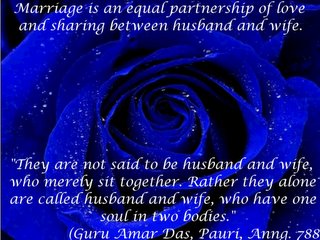 To appraise the status of a society the honor bestowed on the women is the most reliable criterion. All glorious hopes, aspirations, endeavors, yearnings and cravings of the man are bees humming around this flower, the woman. She is a gorgeous fountain of inspiration and exaltation to the man. The woman is so noble, divine and full of love that she drew the whole soul of devotion of the humane men for centuries, but still remained a mystery. The women's forehead we have for centuries focused on as our sky aglow with the calm sparkle of the moon. Poets have written glorious poems to fathom the love and divine in her, but she still remains an unfolded riddle.
To appraise the status of a society the honor bestowed on the women is the most reliable criterion. All glorious hopes, aspirations, endeavors, yearnings and cravings of the man are bees humming around this flower, the woman. She is a gorgeous fountain of inspiration and exaltation to the man. The woman is so noble, divine and full of love that she drew the whole soul of devotion of the humane men for centuries, but still remained a mystery. The women's forehead we have for centuries focused on as our sky aglow with the calm sparkle of the moon. Poets have written glorious poems to fathom the love and divine in her, but she still remains an unfolded riddle.The woman's face veiled with dark tresses has for ever remained concealed and its expression depict only a part of her feelings. The appeal of her eyes and the divinely music of her alluring voice reveal only partly to man. Her divine acts of faith, love and noble self-sacrifice form the base of a beauteous life that gives birth to literature and art that become the vibrant lyrics of poets. Woman has always been the source of inspiration for all the heroic efforts of man to make himself man. The best longings of immortality of man are also an outcome of this source. The best poetry has sprung out of this infinite fountain that embellished the pages of poetry books of which the world is proud.

O'modern woman realise that the secret of your charms is within your veils. Let the mystery of your clothes remain a mighty source of your bewitching enamour. The veil over your face which Guru Amar Das ji told you to remove was a symbol of slavery. He emancipated you from thralldom and gave you the freedom to gaze at the world and estimate its worth. Reckon for yourself the worthiness of this world and demerit those aspects of life that are degrading and impair the beauty of life. Do not forget the Guru who emancipated you to reckon the world.
Guru Nanak Dev ji spoke for you when none had uttered a word to reckon you a worthy human being. None had deemed pertinent to esteem your infinite worthiness to this world. None had reckoned how well you could smoothen the rough edges of life to make it beauteous and flowery. Your existence saturated life with sweet fragrance and the male dominated world enjoyed this fragrance, but refused to reckon your worthiness. Guru Nanak ji revealed this injustice imposed on you by speaking against it. He says on Anng. 473 of the Guru Granth Sahib,
"Within a woman, the man is conceived and from a woman he is born, with a woman he is betrothed and married. With a woman man contracts friendship and with a woman the system of lineage keeps on going. When one's wife dies, another lady is sought for. It is through a woman that man restrains his passions. Why call her bad, from whom are born the kings? "
Guru Amar Das ji denounced the cruel practice of "Sati". On the death of their husbands women were compelled by this custom to immolate themselves on the burning pyres of their husbands. Guru ji says, "That woman is not a "Sati" who burns herself with the corpse of her husband, rather "Sati" is she who suffers from the pangs of separation." Guru Amar Das ji further declares,

There is no religious function in Sikhism where women cannot participate on terms equal to that of men. It is Sikhism that elevated the status of women on par to that of men and life became equipoised and mysteriously fascinating.
The Guru's Praise of Women
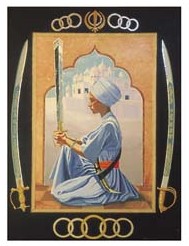 "We are born of woman, we are conceived in the womb of woman, and we are engaged and married to a woman. We make friendship with woman and the lineage continued because of woman. When one woman dies, we take another one, we are bound with the world through woman. Why should we talk ill of her, who gives birth to kings? The woman is born from woman; there is none without her. Only the One True Lord is without woman"
"We are born of woman, we are conceived in the womb of woman, and we are engaged and married to a woman. We make friendship with woman and the lineage continued because of woman. When one woman dies, we take another one, we are bound with the world through woman. Why should we talk ill of her, who gives birth to kings? The woman is born from woman; there is none without her. Only the One True Lord is without woman" Guru Hargobind ji called women
Guru Teg Bahadur blessed the women of Amritsar...
Shakti Women
 ife of Guru Teg Bahadur, mother of Guru Gobind Singh Sahib Ji. Guru Gobind Rai assumed the Guruship at the age of 9. During those early years of his life, his father, Guru Teg Bahadur, decided to make an extensive tour of the eastern parts of India, his purpose was to preach the Sikh faith among the people there. The responsibility for training Gobind Rai was left in the hands of his mother, Mata Gujri Ji. What kind of woman must she have been to be chosen by God to teach and guide Gobind Rai so that he would be capable of assuming the Guruship? He was a human boy, but he had the most divine mother who instructed him in the ways of wisdom so thoroughly that he was ready to take on the responsibility for his destiny when he was nine years old.
ife of Guru Teg Bahadur, mother of Guru Gobind Singh Sahib Ji. Guru Gobind Rai assumed the Guruship at the age of 9. During those early years of his life, his father, Guru Teg Bahadur, decided to make an extensive tour of the eastern parts of India, his purpose was to preach the Sikh faith among the people there. The responsibility for training Gobind Rai was left in the hands of his mother, Mata Gujri Ji. What kind of woman must she have been to be chosen by God to teach and guide Gobind Rai so that he would be capable of assuming the Guruship? He was a human boy, but he had the most divine mother who instructed him in the ways of wisdom so thoroughly that he was ready to take on the responsibility for his destiny when he was nine years old.www.info-sikh.com/ PenPage1.html
Gobind Rai was what he was, but the destiny of his soul was entrusted to Mata Gujri Ji's care it was the touch of his mother through which God could awaken him. And didn't the Gurus teach us - those who are truly married are one soul in two bodies? If this is Divine Truth, can we possibly say that Mata Gujri Ji and Guru Teg Bahadur were one soul in two bodies?
If marriage creates us as one soul in two bodies - then what is the difference between Guru Teg Bahadur and Mata Gujri Ji except that they had two different jobs to do, two different times and spaces, yet sharing one light between them?
She was the woman who created the man who created the Khalsa. And so powerful was her touch that Gobind Rai was ready to lead when he was a nine years old boy.
The Panj Piare: The names of the Panj Piare are inscribed in the heart of every Khalsa.

Bhai Daya Singh, Bhai Dharam Singh, Bhai Mohkam Singh, Bhai Himmat Singh, and Bhai Sahib Singh.
Their act of total surrender and devotion, of being willing to give their heads to the Guru, is celebrated every year at Baisakhi. It was through their selfless courage, absolute love, and total fearlessness that the Khalsa came to life. But do we know the names of their mothers and what their mothers did to raise them with such a consciousness? Everyone has the Light of the Divine within them. That is never the question. But to live that Light unto death - that is a matter of training and the mother is the first training ground of the soul. What values did their mothers instil in them? What discipline? What stories? How did their mothers teach them? What did they teach them? Wouldn't it be wonderful if we had a parenting book for Sikhs based on how these mothers raised these boys? The boys who became the Panj Piare and initiated the order of the Khalsa? Truly, they must have had Khalsa women as mothers, even though the Khalsa had not yet come to life.
When the day comes for the Khalsa nation to truly rise in its glory, greatness and spiritual sovereignty, it will be Khalsa women who lead the way. Women who have crowned themselves as Princesses of Guru Gobind Singh and live in the nobility, dignity and grace of the 10th Master. Women who, with their loving touch, transform their homes into the Ghrist Ashram where meditation and practice of the Guru's teachings are the center of family life.
Where all who need solace, healing and comfort are welcomed with open arms, warm food and kindness. Women who can train their sons and daughters in meditation and Gurbani so that their children do not become confused by doubt and maya, but have such a clear, direct experience of the Divine that they can fearlessly live to the calling of their Spirit and Destiny, even unto death.
For the Khalsa nation to come to life, those who have the destiny to give birth to it must realize their duty. And every Sikh has an obligation to do everything possible to give those Khalsa women a chance to wake up, own their power and change the world.
The Power of the Khalsa Women!

The Chali Mukte: The 40 Liberated Ones. Forty of Guru Gobind Singh's men deserted him at Anadpur. They were afraid to die, afraid for their lives, desperate and starving. They were so concerned with their own survival, that they willing wrote and signed a letter denouncing their Guru. When they arrived home, rather than finding wives joyful for their return, happy that they were alive, what did they find? Wives who were appalled that they had deserted Guru Gobind Singh Sahib Ji. The male side of this story is that the men returned to fight for the Guru and died in the battle, liberating their souls in the process. But the hidden story is:
That the consciousness of their Khalsa wives is what inspired them to do it. The Khalsa women consciously chose widowhood. They would have rather born the burden of seeing their husbands dead, of being left with the sorrow of being widowed, of raising their children alone, of having to find their economic security in the absence of a husband -they would have rather endured all this than to see their husbands walk away from their destinies and betray their Guru.
These women knew - the duty and role of a Khalsa wife is to serve the soul of her husband and deliver him to his destiny and to God and Guru no matter what. Who liberated these men? Themselves? No - it was the grace, security, wisdom and blessing of their wives: that allowed them to be liberated. It was the meditative discipline, the trust in the Divine, the attunement with God's Will through the experience of their own Spirits that allowed these women to look their husbands in the eye and say:
You are dead to us, no matter what! Go back and stand with your Guru or leave!
Minus the spiritual understanding of the women, the 40 Liberated Ones would have never returned to their Guru and would have gone through lifetimes of karma to repay the mistake. These Khalsa  women understood non-attachment, security in the Divine, living in the Will of God, loyalty to the Guru so well that they could fearlessly send their husbands to their death, knowing that it was better for their husbands to die in service of the Guru than to live any other way. And the pain of loosing their husbands was less to them than the pain of seeing their husbands loose their path to God. Publicly- the valour of the men prevailed. Privately- the wisdom of the women prevailed.
women understood non-attachment, security in the Divine, living in the Will of God, loyalty to the Guru so well that they could fearlessly send their husbands to their death, knowing that it was better for their husbands to die in service of the Guru than to live any other way. And the pain of loosing their husbands was less to them than the pain of seeing their husbands loose their path to God. Publicly- the valour of the men prevailed. Privately- the wisdom of the women prevailed.
It was this joint consciousness, valour and wisdom, male and female that displayed the true power of the Khalsa.


